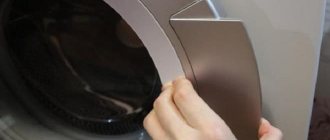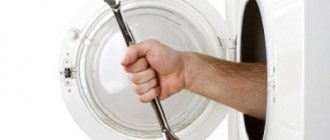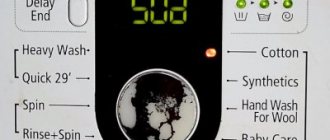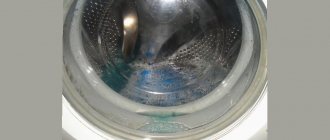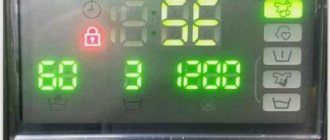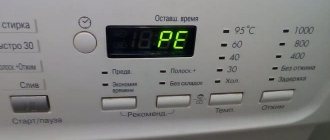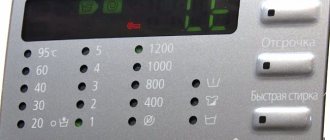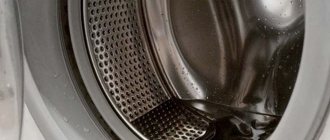It is difficult to overestimate the role of washing machines in everyday life. Unfamiliar with fatigue, the units diligently perform some of the routine duties for their owners. Unfortunately, their mechanisms are prone to periodic failures. Therefore, it is better to find out in advance how to drain the water from the washing machine, so that in case of a breakdown you will know what to do.
We will tell you how to empty the washing machine tank if the programmed work cycle is not completed. The article we presented describes all acceptable, practice-tested methods. Our recommendations will help you properly prepare your equipment for restoration.
Method 1 - through the drain hose
The easiest and fastest way to remove water from a washing machine.
Procedure:
- disconnect the hose from the back wall of the unit and, if it is connected to the sewer, pull it out;
- position the hose below the tank level along its entire length;
- lower its end into the prepared container - the water should flow out on its own.
In this way, you can remove almost all the water from the drum, however, this method is not applicable to all models of washing machines. For example, in some Bosch and Siemens models, the drain hose has a special loop inside the machine body, the main purpose of which is to prevent involuntary drainage of water during washing. Therefore, it will not be possible to remove water from the tank of such models through the drain hose.
You can find out whether your washing machine has such a design feature by referring to the instructions.
Options for removing liquid from the tank
If the automatic machine does not respond to any user commands, then it will not be possible to drain the water using a special program. There are several ways to manually empty the tank. It is necessary to evaluate the situation and choose the preferred method. Main options for forced drainage:
- through the drain hose, without activating the pump;
- unscrewing the waste filter plug;
- opening the hatch door of the washing machine;
- by disconnecting the drain pipe.
Before draining water from an automatic machine, be sure to turn off the power to the equipment and close the shut-off valve.
Regardless of the nature of the problems that occurred in the system, you can use any of the listed methods. Each draining method requires certain preparation. Let's look at what actions will have to be taken when choosing one or another option for removing liquid from the unit.
Drain hose
The simplest method allows you to drain the water the fastest. Procedure:
- Turn off the power, turn off the water supply.
- Disconnect the drain hose from the rear panel.
- Pull the outlet out of the sewer pipe.
- Place the end of the hose in a container (bowl or basin) located below the level of the washing tank. The container required is low; it is difficult to pour into a bucket using this method.
If the washing machine does not drain water in this way, then it is equipped with protection against leakage from the sewer hose. Inside the housing, manufacturers make an additional loop with a drain hose or install a plastic elbow, so the drain hose is always above the level of the tank. Most often found in Bosh and Siemens washing machines.
Emergency hose
Designed specifically for draining water in case of breakdown. It is usually located in a special hatch at the bottom of the front panel and is closed by a small door, where the drain filter is also located. In some cases, the drain mechanism is implemented in the form of a retractable plastic channel. If you do not see the hatch on the front panel, then it is located under the plastic decorative panel at the very bottom. This design is found in Indesit washing machines.
Draining order:
- Open the hatch door and remove the thin emergency hose from the niche.
- Place a flat, wide container of suitable height under the hatch. Remove the plug from the hose and place it with the outlet hole in the container.
- Monitor the process so that the water does not spill.
Important:
all procedures for draining water are carried out only after disconnecting the washing machine from the electrical network and water supply!
Disadvantages of the method:
- Long draining process – up to 30 minutes;
- The emergency hose is often clogged with scale or other debris, so the water will not drain;
- Some models do not have an emergency hose.
Advice:
To speed up the process, tilt the machine against the wall, open the drum hatch, and scoop out some of the water by hand. We drain the remaining water through the emergency hose.
Drain filter
It is located together with the emergency hose, which we wrote about above. Designed specifically to protect the pump from debris, small objects, and lint from clothing. Cleaning the drain filter is the simplest and most common solution to the problem.
Procedure:
- Open the hatch cover at the bottom. Sometimes the hatch door can be covered with a narrow decorative panel at the bottom of the washing machine.
- Tilt the housing towards the rear panel so that you can install a low basin under the filter to collect water. For convenience, you can lean the washing machine against the wall. If the tilt is too high, the rear legs may start to slide on the tiles, be careful.
- Turn the drain filter clockwise by the handle. To adjust the pressure of the drained water, you do not need to unscrew it all the way.
- Keep the machine tilted until water stops flowing into the container. At the end of the drain, you will have to return the device to its normal position, and then collect the remaining water manually.
Advice:
Prepare in advance by laying out rags or towels, this will make cleaning easier after draining the water.
Where is the drain filter in my washing machine?
In models from different manufacturers, drain filters are located in different places. Look for your machine in the list below - perhaps this information will help you.
- LG – the filter is located on the left side under the cover (hatch).
- Indesit and Ariston - in the lower right corner under the removable panel.
- Candy - in the lower left corner under the lid that opens from top to bottom.
- Bosch, Privileg and Siemens - in the lower right corner under the hatch or under the removable strip, depending on the model.
- Electrolux, Atlant and Zanussi - in the lower right corner, which opens from top to bottom.
- Samsung - lower right corner, most often under the removable panel, but sometimes under the hatch cover.
- Whirlpool top-loading - filter in the lower left corner on the front panel under the round hatch.
- Electrolux and Zanussi vertical loading - the filter is built into the ribs of the drum and can only be reached from the inside.
Method 2 - through the drain filter
Almost all models of washing machines have a special filter that protects the drain pump from small objects entering it - coins, paper clips, etc. As a rule, access to this filter is located at the front at the bottom of the unit under a decorative hatch or panel.
To drain water through the pump filter, proceed as follows. Procedure:
- open the decorative sunroof or remove the panel (you may need to use a flat-head screwdriver to do this);
- tilt the washing machine slightly on its side and lean it against the wall so that you can slide a water container under the edge of the machine; be careful that the machine does not slip;
- grab the handle of the filter, turn it counterclockwise (do not unscrew it completely) and drain the water into the prepared container.
The main disadvantage of this method is that a large amount of water can spill onto the floor, and it will have to be removed manually with a rag.
Quantity
The amount of powder required for high-quality washing is determined by the following factors:
- amount of dirty clothes (1 tbsp of powder is enough for 1 kg of dry laundry);
- degree of soiling of the laundry (the more stains, the greater the powder consumption);
- water hardness indicator (high-quality washing in soft water requires less powder than in hard water);
- a specified washing program (in order to wash things in the “cotton” mode, you will need at least 6 tablespoons of powder, and in the “synthetic” mode, only 3 tablespoons of detergent).
Detailed information about the standards for using washing powder can be found on the manufacturer's packaging. Such recommendations should not be ignored.
Exceeding the norm is fraught with problems with drainage (foam, particles of undissolved powder clog the hoses). Also, do not reduce consumption. Saving powder means poor washing quality.
Method 3 - through the emergency drain hose
Some models of washing machines are equipped with a special tube for emergency water drainage. It is located next to the drain pump filter under a decorative hatch or panel on the front of the machine. To drain the water, pull out the tube, remove the cap from it and drain the water into the prepared container. The main disadvantage is that due to the small diameter of the tube, draining can take quite a long time. In addition, not all car models have such an “option”.
Reasons for incomplete drainage of water from the washing machine
No matter what brand of machine you use, no brand protects you from the problem. Don't despair. First of all, you need to understand why this became possible.
Professionals suggest that the reasons for incomplete drainage of water are most often associated with blockages. The following parts of the machine can become clogged and stop draining water:
Filter
During service, the machine's filters may become clogged. Threads, lint, pieces of paper, and small parts that accidentally end up in the drum can clog the filter. If the clog becomes very dense, water can barely pass through the plug. In this case, the solution to the problem is to clean the filter.
Drain hose
Such a blockage can occur not only in the filter. A clogged drain hose becomes an obstacle to draining water. You should also make sure that the hose is not kinked so that water cannot flow freely through it.
Pump
Threads and hair caught inside the pump wrap around the pump impeller blades and interfere with its operation. Removing foreign fibers and cleaning the engine will return the unit to working condition.
Method 4 - directly by opening the hatch
If the previous methods did not help you drain the water from a broken washing machine, you can try to “solve the problem head-on” - open the door and empty the water from the drum manually.
Procedure:
- if the water level in the machine is higher than the bottom edge of the hatch, tilt the washing machine back and carefully lean it against the wall so that when you open the door, water does not spill onto the floor;
- open the washing machine door;
- Scoop out the water using a ladle, mug or jar.
Of course, this method is not very convenient: it takes a long time, does not allow you to completely remove all the water, and, moreover, the machine door can be locked even after disconnecting from the power supply.
Solution
If you have difficulty extracting it, there are methods that can help in this situation.
Using Tools
It is possible that if enough force is applied, the hole can be opened. For this purpose, you can, for example, use pliers.
Knock
There is a chance that debris that is clogged in this part may move and allow it to open. To do this, you need to unplug the machine and remove the water from it.
After this, you need to tilt the washer back 45 degrees. This must be done in such a way that the hole is located on the side that is on top. You need to tap it with your hand. In this situation, there is a chance that small objects will move down and no longer prevent the lid from opening.
Method 5 - through the drain pipe
The last resort option that should be resorted to if all four of the above methods did not bring results or it was not possible to use them (for example, your machine does not have an emergency drain hose) is to force the water to drain through the drain pipe.
Note! As a rule, if water does not drain out when you unscrew the drain filter, this means that there is a blockage in the drain pipe. Therefore, this method, in most cases, will help not only drain the water from the washing machine, but also eliminate the reason why the washing machine stopped running with water.
Procedure:
- remove the back wall of the washing machine and identify the drain pipe, it is located under the drum;
- if possible, place a flat container under the pipe and place dry rags - a flood is imminent;
- remove the clamp that connects the pipe to the pump and disconnect the pipe; water should flow out of it;
- if there is no water, it means there is a blockage in the pipe; Carefully insert your fingers inside the pipe and remove the blockage.
This method is certainly difficult to implement - it will be problematic for the “blonde” to cope with it, but it allows you to completely drain the water from the drum.
Can it be placed directly into the drum?
There is a myth that by pouring washing powder directly into the drum of the washing machine, you can reduce detergent consumption.
In fact, this is not true. If washing powder is mixed with water in measured doses from the powder receptacle, the detergent is washed out of the washing machine drum very quickly, which has an extremely negative effect on the quality of the wash.
Also, pouring powder into the drum increases the risk of laundry damage (undissolved particles of bleaching substances can cause whitish spots and streaks on colored fabrics).
You can pour powder into the drum of the Indesit washing machine only in exceptional cases:
- there is a problem of lack of water pressure (as a result, the washing powder remains in the powder receiver tray);
- Due to internal problems, the washing machine does not pick up the detergent poured into the tray.
A special dispenser will help you pour washing powder into the drum correctly (without negative consequences for laundry and household appliances). This is a small plastic jar with a large number of holes in the lid.
The dispenser is filled with detergent and then placed inside the drum along with dirty clothes. The powder is gradually mixed with water through the holes of the dispenser, thereby ensuring maximum washing quality.
Common breakdowns when the machine does not drain
Let us immediately make a reservation that stopping the washing machine with water does not always mean a breakdown of the unit. In some cases, the problem can be resolved on your own - read about this in the article “Why the washing machine does not drain water.”
Below are the most common breakdowns that lead to the machine stopping draining water.
Pump breakdown - from 1600 rubles.
The drain pump burned out, so the washing machine stopped draining water.
Signs
The machine does not drain, there is no noise from the operation of the drain pump.
How to fix
The pump needs to be replaced with a new one.
Clogged drain filter - from 1100 rubles.
The drain filter serves to protect the pump from small objects and debris that may be found in laundry items. During operation, the filter could become clogged. RemBytTech specialists often find coins, buttons, and toothpicks in it.
Signs
The washing machine does not drain.
How to fix
The filter needs to be cleaned.
Malfunction of the programmer (in mechanical models of washing machines) or control module in electronic ones - from 2000 rubles.
In this case, the signal from the board does not go to the pump motor. As a result, it does not start working and the water does not drain.
Signs
The SMA does not drain water. Perhaps the programs are going wrong.
How to fix
The control board needs to be repaired or replaced.
Breakdown of the pressure switch (water level sensor) - from 1600 rubles.
The level sensor is stuck in the empty tank position, so the washing machine stops with water and does not drain. The pressure switch hose could also fly off or become damaged.
Signs
There is no drain in the washing machine.
Additionally
After getting rid of the water, conduct a test run . If the device does not function normally, you need to understand the cause of the breakdown.
You should check whether the pump impeller, located behind the filter, rotates freely and remove any foreign objects that are interfering with it, if any . Next, set the spin mode and shine a flashlight into the filter hole. If the impeller still does not rotate, the drain pump needs to be replaced. To do this, remove the drain assembly and detach the old drain pump and wires from it. The new pump is placed in place of the old one and the wires are attached to it.
In addition, the cause of the problem could be a software glitch or the electronic module could break.
In the first case, the machine with the drained water needs to be dried for a while and then started again. In the second, you need to solder the tracks or replace the relays and triacs responsible for the operation of the drain mechanism. In some situations it is necessary to change the module.
When it becomes necessary to drain the water
Sometimes washing machines break during washing. You can clean the pipes yourself. It is better to entrust the repair of the engine and other components to a professional, but you should start by draining the water.
If you leave it, things may become stagnant, and clothing and equipment itself will develop an unpleasant sewer smell. Therefore, the first thing you need to do is get rid of liquids. If you do not drain the water thoroughly, mold may appear inside the device, which is quite difficult to get rid of.
Listed below are the most common and effective tips on how to remove stagnant water from your washing machine.

